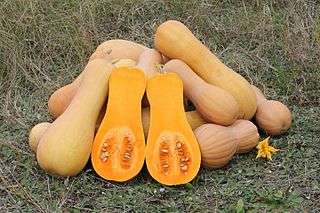Winter squash

Winter squash is an annual fruit representing several squash species within the genus Cucurbita. It differs from summer squash in that it is harvested and eaten in the mature fruit stage when the seeds within have matured fully and the skin has hardened into a tough rind. At this stage, most varieties of this fruit can be stored for use during the winter. Winter squash is generally cooked before being eaten and the skin or rind is not usually eaten as it is with summer squash.[1]
Planting and harvesting
Because squash is a frost-tender plant, the seeds do not germinate in cold soil. Winter squash seeds germinate best when the soil temperature is 21 to 35 °C (70 to 95 °F), and the warmer end of the range is optimum.[2] Winter squash is harvested whenever the fruits have turned a deep, solid color and the skin is hard. Most winter squash is harvested in September or October in the Northern Hemisphere, before the danger of heavy frosts.
Nutritional value
| Nutritional value per 100 g (3.5 oz) | |
|---|---|
| Energy | 143 kJ (34 kcal) |
|
8.59 g | |
| Sugars | 2.2 g |
| Dietary fiber | 1.5 g |
|
0.13 g | |
|
0.95 g | |
| Vitamins | |
| Vitamin A equiv. |
(9%) 68 μg (8%) 820 μg38 μg |
| Thiamine (B1) |
(3%) 0.03 mg |
| Riboflavin (B2) |
(5%) 0.062 mg |
| Niacin (B3) |
(3%) 0.5 mg |
| Pantothenic acid (B5) |
(4%) 0.188 mg |
| Vitamin B6 |
(12%) 0.156 mg |
| Folate (B9) |
(6%) 24 μg |
| Vitamin C |
(15%) 12.3 mg |
| Minerals | |
| Calcium |
(3%) 28 mg |
| Iron |
(4%) 0.58 mg |
| Magnesium |
(4%) 14 mg |
| Manganese |
(8%) 0.163 mg |
| Phosphorus |
(3%) 23 mg |
| Potassium |
(7%) 350 mg |
|
| |
| |
|
Percentages are roughly approximated using US recommendations for adults. Source: USDA Nutrient Database | |
Winter squash is low-calorie and a good source of complex vegetable carbohydrates and dietary fiber. It is an excellent source of vitamin A, a great source of vitamin C, potassium, dietary fiber and manganese, and a good source of folate, omega-3 fatty acids, vitamin B1 (thiamin), copper, tryptophan, vitamin B6 (pyridoxine), vitamin B3 (niacin) and vitamin B5 (pantothenic acid).[3] It is also a source of iron and beta-carotene. Usually, the darker the skin is, the higher the beta-carotene content.[4]
Subspecies, cultivars and varieties

- Ambercup squash
- Arikara squash
- Atlantic Giant
- Banana squash
- Buttercup squash
- Georgia candy roaster
- Hubbard squash
- Jarrahdale pumpkin
- Kabocha
- Lakota squash
- Mooregold squash
- Red kuri squash (also called "Hokkaido squash" or "baby red Hubbard squash")
- Turban squash
- Cushaw squash (also called "winter crookneck squash")
- Butternut squash
- Dickinson pumpkin
- Long Island cheese pumpkin
- Fairytale pumpkin squash or Musquee de Provence[5]
- Kent Pumpkin
- Acorn squash
- Carnival squash
- Delicata squash
- Field pumpkin
- Heart of gold squash
- Spaghetti squash
- Sweet dumpling squash
- Autumn cup squash
- Calabaza
- Giraumon
- Gold nugget squash
- Sugar loaf squash
References
- ↑ "Winter Squash". University of Illinois Extension. Retrieved September 15, 2013.
- ↑ Nonnecke, Ib Libner (1989). Vegetable Production. New York: Van Nostrand Reinhold. p. 534. ISBN 0-442-26721-5.
- ↑ "Squash, winter". whfoods.org. The George Mateljan Foundation. Retrieved 2013-08-28.
- ↑ "Vitamin A". National Library of Medicine, National Institutes of Health. Retrieved September 15, 2013.
- ↑ "Squash". What's Cooking America. Retrieved 2013-08-28.
